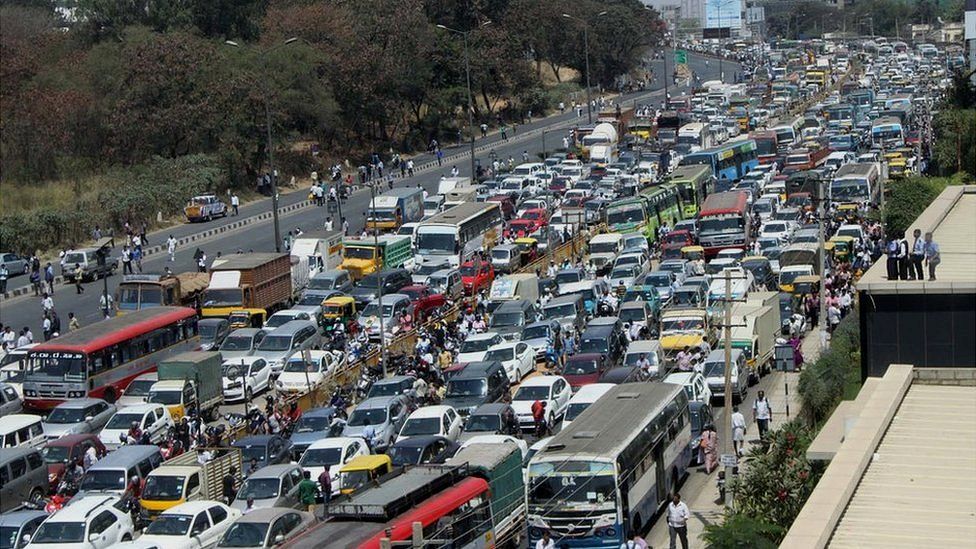Why is Bangalore stuck in traffic jams?
- Published

The hottest topic of conversation in Bangalore these days is traffic, writes the BBC's Geeta Pandey who spent 10 days in the southern Indian city recently.
A few days ago, popular British author Jeffrey Archer was in the city to launch his latest book when he had a taste of Bangalore's notorious traffic jams.
"A woman walking on the pavement overtook my car eight times and my car overtook her eight times. Two more times and we would have been engaged," he later told the more than 3,000 fans who had gathered for the event.
The writer's humour made his fans smile, but many Bangaloreans stuck daily in the city's nightmarish jams are not amused.
I've visited Bangalore many times in the past, but this time whenever I called anyone to fix an appointment, the directions came with a warning, "Start early to factor in traffic delays."
"The traffic is definitely a mess here," says transport and traffic expert Prof MN Sreehari. "It's faster to walk than drive."
"In 2005, traffic moved at the speed of 35km (22 miles) an hour; in 2014, it had slowed down to 9.2km (5.7 miles)," says Pawan Mulukutla of the non-profit World Resource Institute, adding that "at traffic junctions, the wait time is more than five minutes when it should ideally be two-three minutes."
Today, at peak times, the speed is just 4-5km on the city's key Outer Ring Road.
Reports say an average citizen spends more than 240 hours stuck in jams every year and Prof Sreehari estimates that traffic delays cost the city 65bn rupees ($950m; £760m) a year.
So why is Bangalore gridlocked?
Everyone I spoke to agreed that it was because of the rapid - and unplanned - growth of the city.
Bangalore is often described as the Silicon Valley of India as it is home to the IT industry.
Since the early 1990s, global technology firms began opening offices here and a large number of support industries have grown around it, bringing with them a huge influx of people from all over India.
"Bangalore became the new El Dorado," says city resident V Ravichandar. "And the population grew from 5.6 million in 2001 to 8.7 million in 2011. Today, it's estimated to have reached 11.5 million."
Mr Mulukutla says the population has doubled, but the infrastructure has failed to keep pace.
"We have only 6,500-7,000 public buses to carry 45% of the city's traffic. The Metro construction has been very slow. Work on the first line started in 2007 and so far only 28km of the 42km line have opened. Work on the second phase has not even begun. And deadlines keep getting pushed."
So most people are dependent on private transport. Prof Sreehari says the city has 6.6 million private vehicles, including one million cars. And every day, another million vehicles enter from outside the city, clogging its already choked streets.
Adding to the problem, he says, is the fact that one-third of the city roads are taken away by parking and encroachments.
"Roads are meant for traffic, but there's parking everywhere. Footpaths are meant for pedestrians, but they are occupied by hawkers and vendors."
So is there a way out?
"We need firm decisions from the authorities, but there is a lack of vision," believes Prof Sreehari.
"More than 3,500 vehicles are registered in the city daily. That number needs to be restricted. We need to make licensing stricter, car purchases should be taxed heavily and heavy fines should be charged to curb roadside parking," he says.
Mr Ravichandar says the answer lies in faster public transport. "We need more investment in public transport. If we increase the number of buses to 9,500 to 10,000, it will make a difference," he says.
"The government instead comes up with ideas like constructing a steel bridge and elevated corridors," says Mr Mulukutla.
"Building new flyovers can change the pain point, but they are not a permanent solution," he adds.
Prof Sreehari says any new flyover will be clogged in five years.
"What we need is a comprehensive integrated sustainable public transport system, something like a central transport authority like you have in London or Singapore. Our culture of working in silos and different transport systems, not talking to each other, is not going to work."
But as that is unlikely to happen soon, the situation is "expected to get worse before it gets better", says Mr Ravichandar.
Bangalore, at least in the near future, will continue to remain gridlocked.
- Published17 November 2016
- Published23 November 2016